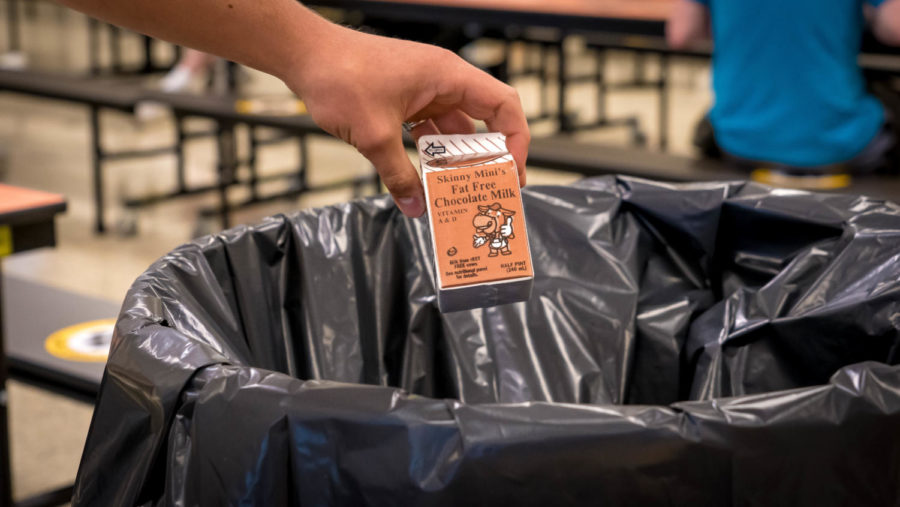Got Waste?
Students are encouraged to take milk as part of NA’s free lunch program, but dairy production and waste can be especially problematic.
Unopened milk is often thrown away by students who thought they had no choice but to take it.
May 11, 2021
In March, the United States Department of Agriculture (USDA) announced that they would be taking steps toward universal free lunches for American youth through summer.
Similarly, back in October of 2020, the North Allegheny School District announced their decision to offer free school lunches to all students either through pickup or directly from the buildings’ lunch lines during school hours.
Even though I have not gotten lunch from the school this year, I was overjoyed when I heard this news. All students, no matter their financial status, deserve a proper meal during the school day, or no one should expect them to perform to the best of their abilities.
However, no student should have to unwillingly participate in larger problems such as widespread food and other material waste, environmental destruction, and even personal health issues just because they decide to get lunch from the school.
According to NA’s Food Services program, the only participants who must take milk are people who pick up free lunches rather than getting them during the school day. Students who get lunch during the school day are only required to get three of five components including a grain, protein, fruit, vegetable, and milk. These guidelines are all in accordance with USDA regulations.
In spite of this, many students who get lunch from school at both NASH and NAI seem to believe that they have to take milk along with the rest of their lunch in order for it to be free. Some say that staff in the cafeteria have even told them that they must take milk.
Even if this is simply due to some sort of miscommunication, there is clearly a problem with how the policy surrounding milk is being carried out. It does not matter if there is no rule requiring students to get milk if it seems like there is one.
Although even recommending students get milk does not seem like much of a problem, doing this contributes to a wide range of issues that are severe regardless of whether or not the school knows what they are doing is wrong.
For a long while, the dairy industry has done a tremendous job of adding pro-milk curriculums and programs to schools on a national level, especially for elementary-age students. Despite the fact that milk is bad for the environment and health, unthinkable amounts of money are spent on lobbying this pro-milk agenda. Thus, many American students are raised to believe in the benefits of milk, so we cannot expect students to make an informed decision in the lunch line.
Hundreds of millions of cows raised for dairy across the United States produce large amounts of greenhouse gas emissions or methane gas. Since farmed animals in the US produce 130 times more waste than all humans combined, this methane gas is being produced at unimaginable and unsustainable rates.
In the 20th century, this methane accounted for about 23% of climate change. As climate change leads to a wide range of natural disasters as well as a lessened quality of life and widespread famine and disease, lowering dairy production and, in turn, decreasing rates of methane gas production, should be an obvious first step to reducing climate change.
Additionally, manure and fertilizers that are handled improperly can run into nearby water sources, polluting them and often rendering them unsafe to drink.
The school district is not directly responsible for this issue, nor can they do much to reduce rates of dairy production, methane emissions, or even water waste. What they can do, though, is stop feeding into the false narrative that dairy production isn’t extremely harmful to the environment. They can also step back when it comes to making kids get milk when it is not absolutely necessary or required by the USDA.
In addition to other environmental issues, making students think that they need to get milk contributes to school-wide waste. Unopened milk containers are thrown in the trash with little regard for the environmental impact, wasting both the milk and the container that it comes in.
At the same time, however, the students that do this are not entirely to blame. Even if they are fully aware of the waste that this causes, if they feel forced to take milk, they should not also feel forced to drink it.
While some milk lovers may argue that the health benefits of milk overpower the threat that the drink poses to the environment, it turns out that milk is not even that good for you.
It is not entirely false that milk can contribute to strong, healthy bones, which require calcium, but milk itself is not the only way to get this calcium, nor is it the best source, mostly because of the many health problems that it can lead to.
Milk can cause multiple forms of cancer in both men and women. It can even cause E. coli and salmonella, and unknowingly drinking milk from cows that have developed antibiotic-resistant bacteria as a result of overuse of antibiotics in unclean agricultural environments will only make it harder to get over these ailments.
In spite of the fact that students getting lunch from the school are allowed to reject the milk if they are vegan or lactose intolerant, it is likely that some students do not know the extent to which their body rejects lactose if they have not received a professional diagnosis of lactose intolerance, even though around 30 million Americans are lactose intolerant by the age of twenty.
Healthier and safer alternatives to milk and other dairy include almond, soy, rice, coconut, and hemp milk, and the best choice for you depends on allergies and taste among other factors.
Even though the school is held back by USDA standards in some ways, there are steps we can take to lessen this issue.
To avoid food and other waste, the district should donate, recycle, or compost certain items if necessary, rather than get rid of them. Additionally, they should keep track of the cafeteria’s waste in some way in order to understand what they are currently doing wrong and try to create new plans to fix these things.
If students do not have to get milk, this fact should be made clear and students should not have to do any digging to find it out. Miscommunication about whether or not students are required to get milk must be cleared up.
If the district makes all of the effects of milk, including the negative ones, more clear rather than attempting to hold pro-milk campaigns and convince students only of the benefits from a young age, students will be able to make their own decision about whether to open the carton or keep it from adding unnecessarily to the local landfill.












